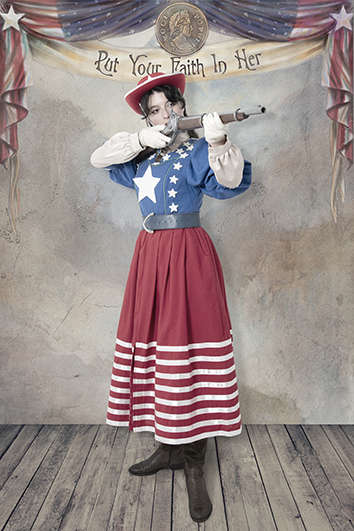MANIFEST DESTINY PORTRAITS is a photographic project inspired by the American myth of the West. The peculiarity of American epic is that it created its Frontier mythology using contemporary events and characters. Explorer and frontiersman Daniel Boone, soldier and bison hunter Buffalo Bill with his Wild West Show, famous sharpshooter Annie Oakley, one of the very few female celebrities of her time: they were all heroicized during their lifetime. The frontier mythology transcended the real history of American expansion and reconstructed contemporary events as shared myths to promote an idealized view of them. A narrative which was necessary to pass the brutal expansionism of the colonies and the genocide of Natives for a “civilizing mission”; American journalist John Louis O’Sullivan coined the expression Manifest Destiny to refer to the divine right of the American colonies to expand over and possess the whole continent to defend and promote their idea of freedom and democracy. This concept was used to convince the public opinion that these processes of invasion and homogenization, directed by the political and especially by the economic elites, were instead a product of the ideas, the character and the aspirations of the American people. Predictably, this mythical narrative did not provide a faithful representation of reality, and it focused on certain figures while ignoring others: its protagonists were the typical white, male, epic heroes, the solitary adventurer, the courageous soldier, the intrepid frontiersman. There were very few farmers, even less women, and Native Americans were depicted as the savage antagonists and only served to further emphasize the heroes’ virtue and prowess. American historians also created the Vanishing Indian trope, which predicted that Natives were a vanishing race, destined to succumb to the superior culture of the white man. This myth was used to justify the expropriation of lands which Native Americans had inhabited for thousands of years. The Vanishing Indian myth fortunately did not become a reality and Native American communities today still promote and protect their heritage and one of the most fascinating and “progressive” cultures in the world; a culture in which women are held in high regard and the earth is revered as divine. The Manifest Destiny philosophy, albeit devoid of its myths, has continued to influence U.S. foreign policy through the years and today many white Americans, like their forefathers before them, still believe it is their ‘manifest destiny’ to impose their culture everywhere in the world.
Daniel Boone: “All you need for happiness is a good gun, a good horse, and a good wife.”
ITA
MANIFEST DESTINY PORTRAITS è un progetto fotografico ispirato al mito americano della conquista del West. L’epica statunitense ebbe la peculiarità di costruire i propri miti in contemporanea con gli avvenimenti, a partire da fatti, vicende, figure e luoghi che erano lontani nello spazio ma vicini nel tempo. L’esploratore settecentesco Daniel Boone, il cacciatore di bisonti Buffalo Bill con il suo Wild West Show, la celebre tiratrice Annie Oakley, una delle pochissime donne famose dell’epoca: ognuno di loro fu trasformato in eroe leggendario mentre era ancora in vita. La mitologia trascende la vera storia della frontiera americana e trasforma eventi contemporanei in mito condiviso per dare di essi una visione idealizzata. Un’operazione necessaria per trasformare il brutale imperialismo americano e lo sterminio degli indiani in una “conquista” intesa come forma di progresso e di civilizzazione; il giornalista statunitense John Louis O’Sullivan sintetizzò con l’espressione “Destino Manifesto” (Manifest Destiny) la convinzione che gli Stati Uniti d’America avessero la missione divina di espandersi per diffondere la loro forma di libertà e democrazia, dando all’opinione pubblica l’impressione che questi processi di invasione e omologazione, decisi dalle classi dirigenti, soprattutto economiche, nascessero invece dalle idee, dalla vita, dalla fantasia del popolo. Nella narrazione mitologica americana non c’era certo spazio per tutti: erano privilegiate le figure riconducibili alle forme classiche dell’epica, gli eroi solitari, i soldati valorosi, gli intrepidi conquistatori. C’erano invece pochi contadini, pochissime donne e gli indiani erano descritti solo come feroci antagonisti, per dare ancor più valore e risalto alle imprese degli eroi. Gli storici americani crearono anche il mito del Vanishing Indian, secondo il quale i nativi erano destinati a “scomparire”, a estinguersi, poiché non potevano reggere all’impatto con la civiltà e la cultura dell’uomo bianco. Il mito serviva a giustificare l’espropriazione delle terre dei nativi che, sebbene le abitassero da anni, non potevano accampare nessun diritto su di esse perché destinati comunque a essere cancellati dalla superiore cultura anglosassone. Il mito del Vanishing Indian fortunatamente non si è avverato e le minoranze di nativi americani rimasti tengono in vita ancora oggi una delle culture più affascinati e “progressiste” che abbiano abitato il nostro pianeta; una cultura in cui la donna è tenuta in grande considerazione e la terra viene venerata come una divinità. Anche se privata delle figure mitologiche che l’hanno caratterizzata nei secoli scorsi, la filosofia del Manifest Destiny influenza ancora oggi la politica degli Stati Uniti e, come i loro antenati prima di loro, molti americani bianchi credono che sia il loro ‘destino manifesto’ imporre la propria cultura ovunque nel mondo.
Daniel Boone: “Tutto ciò che serve per la felicità è un buon fucile, un buon cavallo e una buona moglie.”
